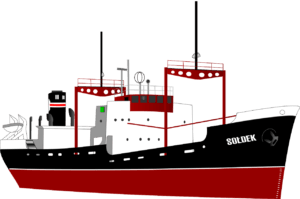By:
Published:
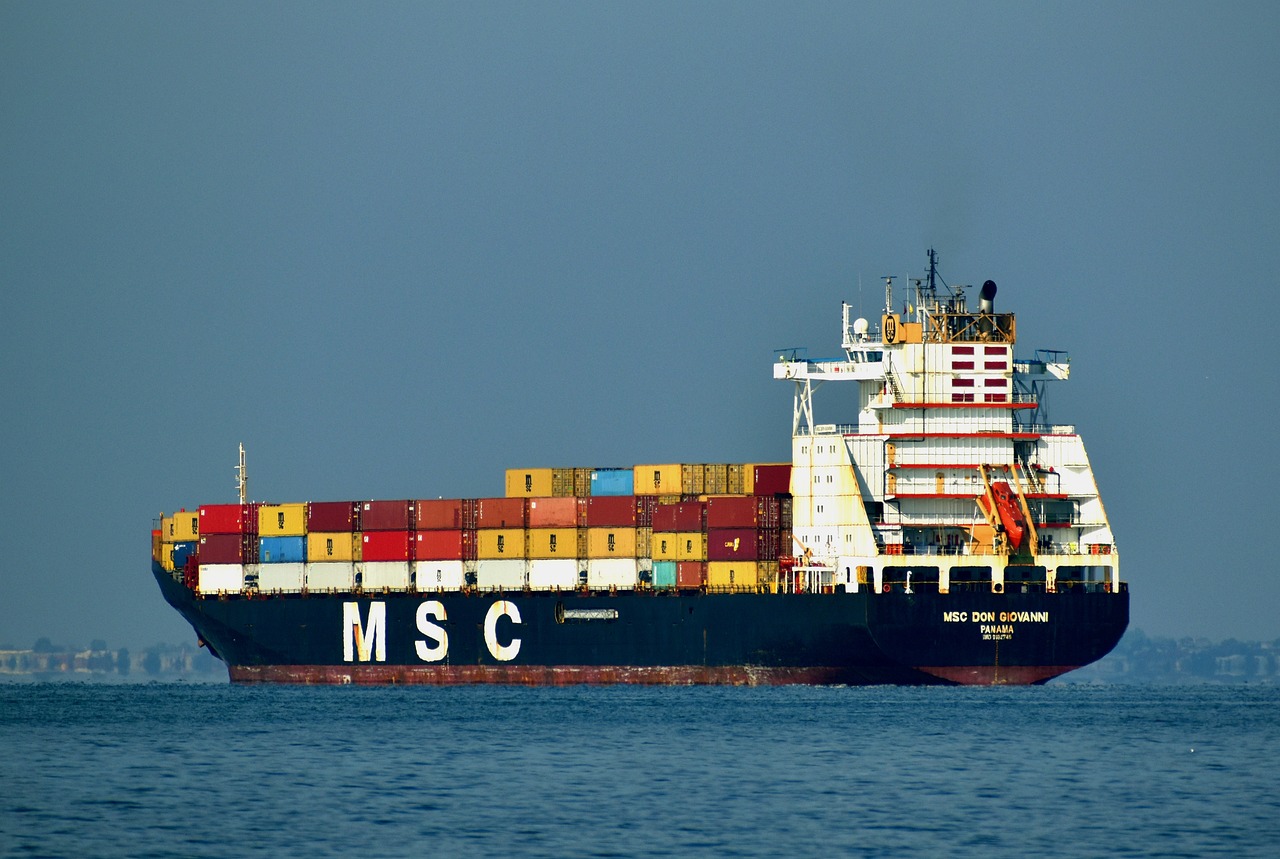
If the words ‘Ship Spotting’ make you yawn:
I challenge you to change your mind…
Picture this:
Uncover the rich stories behind each vessel, get a glimpse into the hidden world of global commerce, and witness the extraordinary power of human innovation…
Forget boredom – ship spotting is an exciting adventure!!
So what’s all the fuss about?
Ever scrolled through social media and seen someone post a picture of a giant ship, wondering what the big deal is?
Well, ship spotting is so much more than just watching boats go by.
It’s a gateway to a whole hidden world filled with adventure, history, and the very pulse of global trade.
Imagine yourself standing on a pier, the salty breeze whipping your hair.
Suddenly, a colossal container ship glides into view, stacked high with colorful boxes:
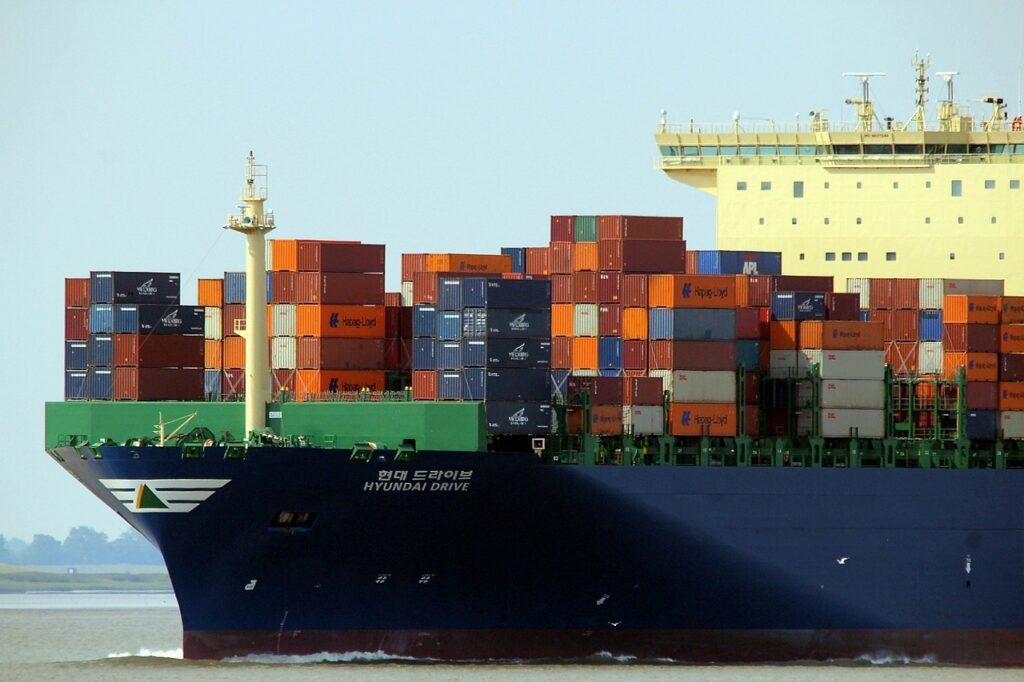
BUT answer me this:
- Where did it come from?
- What cargo does it have on board?
- Will any of the goods on board end up in a shop that you go to?
Ship spotting becomes a global treasure hunt, letting you connect the dots between those everyday items on your supermarket shelf and the faraway lands they originated from.
Surely that’s just a LITTLE bit interesting?
But it’s not just that…
Every ship that traverses the waves carries echoes of the past.
Picture the daring explorers who first mapped uncharted waters, or the mighty warships that clashed in epic battles.

Ships are living testaments to human ingenuity and a tangible reminder of how our world has become so interconnected.
But ship spotting isn’t just about grand narratives. It’s about the thrill of the unknown.
Every ship that passes by is a puzzle waiting to be solved.
Is it a sleek cruise liner carrying excited holiday makers, or a behemoth cargo ship hauling the building blocks of our modern world?
With a little research, you can become a maritime detective, unraveling the mysteries of these giants of the sea.
The best part? You don’t need fancy equipment or years of training to get started. All you need is a curious mind and maybe a pair of binoculars.
Find a spot with a good view of the water, and let the adventure begin. You might be surprised at how quickly you become captivated by the rhythmic thrum of engines, the graceful movements of the ships, and the stories they silently carry.
So ditch the usual distractions and embrace the unexpected.
Ship spotting offers a unique blend of relaxation and discovery, a chance to connect with the world around you and appreciate the incredible human effort that keeps things running smoothly.
Give it a try, and you might just become the next ship spotting enthusiast!
🚢What’s In This Guide…
⚓️Learn about ‘MarineTraffic.com’ – your virtual eyes in the world of shipping
⚓️11 Fun ways to use ‘MarineTraffic.com’
⚓️Tips for exploring real world ports and coastlines
⚓️Outdoor ship spotting equipment
⚓️How to identify some of the major ship types
⚓️Learn the names for different parts of a ship
⚓️Ways to develop your interest in the hobby
1. Unveiling the Mysteries: MarineTraffic.com and Beyond
Let’s face it, even the most dedicated landlubber might not have a constant view of a bustling port.
But fear not, intrepid ship spotter! Technology brings the world’s oceans to your fingertips.
And this is where I recommend you START your ship spotting journey…
Websites like MarineTraffic (https://www.marinetraffic.com/) act as your virtual binoculars, letting you track ships in real-time across the globe.
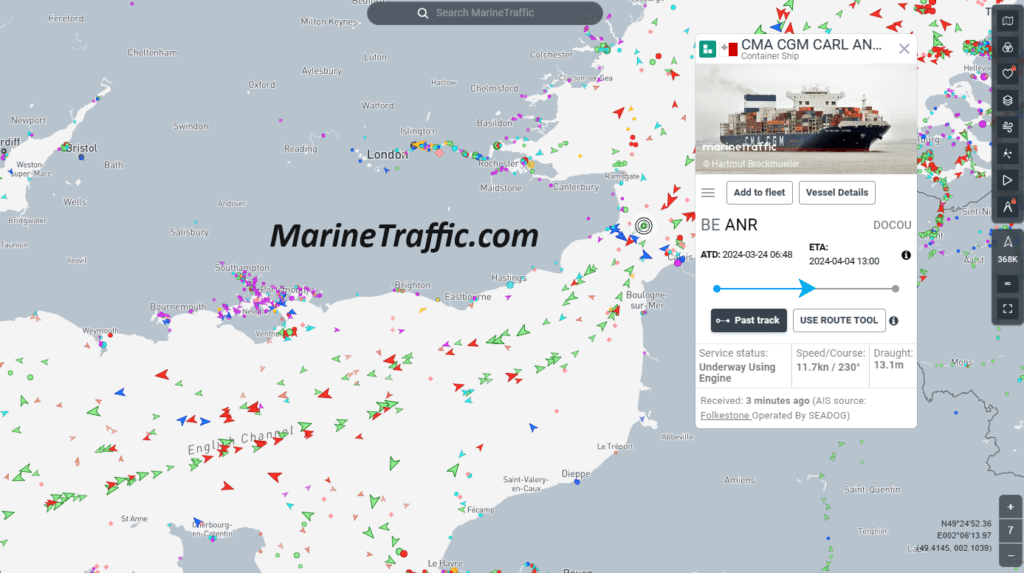
What you can do on MarineTraffic.com
Ever wondered what massive cargo ships are hauling across the globe, or where that cruise liner you saw on the horizon might be headed?
Set sail on a virtual voyage of discovery with MarineTraffic.com, a free website that lets you explore the world’s oceans like never before!
Become a Captain from Your Couch:
Imagine a giant map of the world, but instead of countries and cities, it shows thousands of real ships gliding across the seas in real-time!
That’s the magic of MarineTraffic’s Live Map.
See container giants and luxurious cruise ships, spot agile tugboats guiding behemoths into port, and even track military vessels on patrol.
It’s like having your own personal global shipping channel, all from the comfort of your home.
Dive Deeper: Ship Detective
Curious about a particular vessel? MarineTraffic lets you play maritime detective! Simply type in a ship’s name or a special identification number, and unlock a treasure trove of information.
Discover where the ship is heading, where it’s been, and even its estimated arrival time.
Learn the type of vessel it is – is it a mighty oil tanker carrying a fortune in black gold, or a sleek container ship stacked with goodies from all corners of the world?
Build Your Dream Fleet:
Imagine having your own personal fleet of fascinating ships to follow! With MarineTraffic’s free My Fleet feature, you can create a custom list of vessels that pique your interest.
Maybe you want to track the progress of a cargo ship carrying your online order, or follow a cruise liner a friend is about to embark on.
MarineTraffic keeps you updated on their movements, so you can virtually sail alongside them on their exciting journeys.
More Than Just Maps and Boats:
MarineTraffic isn’t just about cool ship stuff (although there’s plenty of that!). You can also browse a collection of ship photos submitted by users around the world, getting a closer look at these magnificent vessels.
So, if you’ve ever dreamt of exploring the high seas or have a curious mind that loves to track and explore, set sail for MarineTraffic.com today. It’s a free and fascinating journey waiting to be discovered!
How Does MarineTraffic Work?
You may be wondering how these sites know where all the ships are? It’s all thanks to a clever technology called Automatic Identification System (AIS).
Most commercial vessels carry AIS transponders that broadcast the ship’s position, course, speed, and other details.
A network of shore stations receives these signals, feeding the data to websites like MarineTraffic.
👇Interesting FACT: 👇
AIS was designed primarily for safety and collision avoidance at sea. Knowing a ship’s location and course helps captains navigate busy waters and avoid accidents.
2. MarineTraffic: Your Ship Spotting Superpowers Revealed (11 Cool Ideas)
Okay, forget staring at the waves and hoping for excitement! With MarineTraffic, you hold the keys to a treasure trove of maritime mysteries.
Whether you’re a seasoned seafarer or a curious landlubber, this website transforms your screen into a portal to the exciting world of ships.
Ready to set sail on a virtual adventure?
Here are 11 ways to chart your course with MarineTraffic:
- The Global Treasure Hunt: Pick a familiar item in your home – maybe your phone or a piece of fruit. Where was it made? Head to MarineTraffic and search for major ports in that country. Click on cargo ships leaving those ports and track their journeys. Chances are one of them brought the building blocks of your everyday items!
- Follow the Giants: Ever seen those colossal container ships on the horizon? MarineTraffic lets you get up close and personal! Search for the largest container ships in the world (hint: some names start with “Ever”) and follow them across oceans. Where are they headed? What treasures might they be carrying?
- MSC Irina-Class: This group of ships currently holds the title of the world’s largest container vessels. Here are a couple of them:
- MSC Irina: IMO 9935950 (Capacity: 24,346 TEU)
- MSC Loreto: IMO 9935962 (Capacity: 24,346 TEU)
- Evergreen Ever Alot-Class: This class previously held the title. Some notable ships include:
- Ever Alot: IMO 9893955 (Capacity: 24,004 TEU)
- Ever Arm: IMO 9893967 (Capacity: 24,004 TEU)
- Ever Ace: IMO 9893890 (Capacity: 23,992 TEU)
- HMM Algeciras-Class: These massive ships were some of the world’s largest for a period of time:
- HMM Algeciras: IMO 9863297 (Capacity: 23,964 TEU)
- HMM Oslo: IMO 9863302 (Capacity: 23,964 TEU)
- What is an IMO number?
- An IMO (International Maritime Organization) number is a unique 7-digit identifier assigned to ships for safety and identification purposes. It stays with the vessel throughout its lifetime.
- Important to Note: The world of container ships is constantly evolving. New ships with larger capacities are always being built, so the list of the largest ships can change over time.
- Where to Find the Latest
- You can find the most up-to-date listings on websites like:
- MarineTraffic: (https://www.marinetraffic.com/)
- Wikipedia’s List of Largest Container Ships: (https://en.wikipedia.org/wiki/List_of_largest_container_ships)
- MSC Irina-Class: This group of ships currently holds the title of the world’s largest container vessels. Here are a couple of them:
- Your Local Waterway Watch: Live near a coast or a river? Zoom in on your local area on MarineTraffic and discover the hidden traffic! Tugboats, ferries, fishing vessels – there’s a whole world of activity beyond the giant ships. Can you identify the types of vessels that frequent your waters?
- Cruise Critic: Dreaming of a voyage at sea? MarineTraffic is your inside scoop on cruise ships! Track the world’s most luxurious liners, explore their itineraries, and see where they’re headed next. Maybe you’ll find inspiration for your next adventure!
- Port Explorer: Choose a major port anywhere in the world (think Singapore, Rotterdam, or Los Angeles). Zoom in on MarineTraffic and spend some time “window shopping” the ships. You’ll see everything from giant tankers to tiny fishing boats. Can you identify the different types?
- Ship Spotting Bingo: Create your own ship spotting challenge! Make a list of ship types you’d like to find (container ship, car carrier, oil tanker…) and use MarineTraffic to track them down. Bonus points for spotting rare or unusual vessels!
- Spot the Odd One Out: Zoom in on a busy section of the MarineTraffic map. Can you find a ship traveling against the flow of traffic, or one headed in a surprising direction? Investigate why it might be taking an unusual route.
- Follow the Weather: Major storms and weather events can disrupt shipping routes. Search for news articles about a recent storm, and then head to MarineTraffic. Can you see how the storm has affected ship movements? Are any ships taking detours or seeking shelter?
- Reverse Journey: Did you spot a ship in real life? Note down its name, head to MarineTraffic, and search for it! Trace its journey back in time. Where has it been? What amazing voyages has it undertaken?
- The Name Game: Ship names can be fascinating. Some are grand, some are quirky, and some are downright funny. Browse ships on MarineTraffic and take note of the interesting names. Search them up and see if you can discover the stories behind them.
- Maritime Art: MarineTraffic’s visuals aren’t just for navigation! Check out the ship photos or explore the map with satellite view. You might discover beautiful compositions or interesting patterns created by shipping lanes. Screenshot these for inspiration – you might have your next art project!
3. Exploring the Real World: Ports, Coastlines, and Common Sense
While MarineTraffic is a fantastic tool, there’s nothing quite like the thrill of seeing a ship in person.
Ports are a natural hub for ship spotting, offering a front-row seat to the mesmerizing ballet of loading, unloading, and maneuvering.
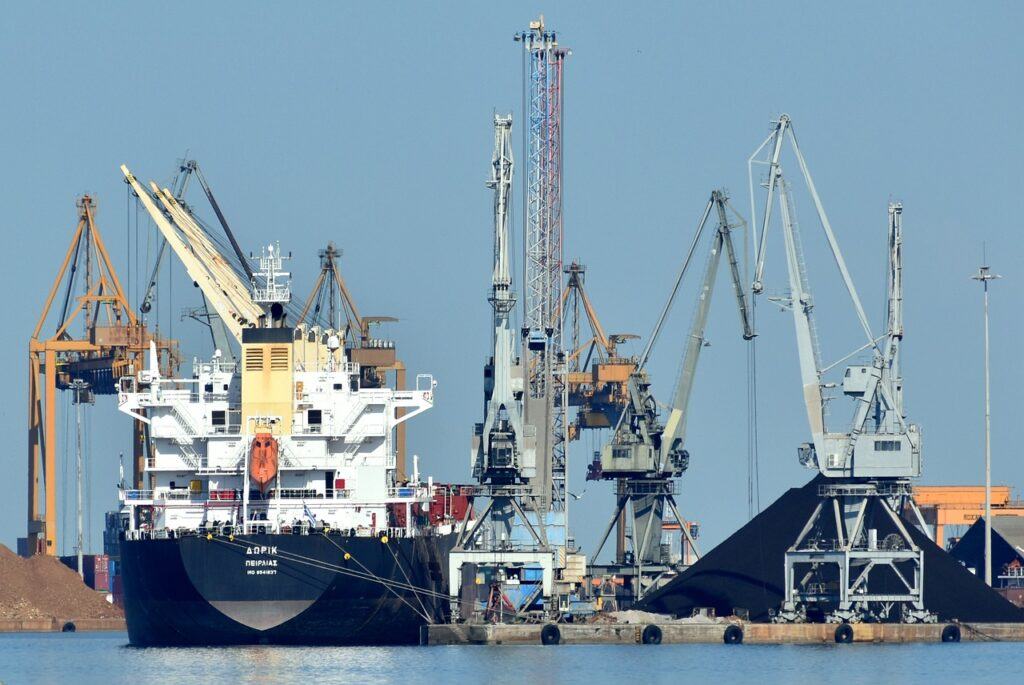
But remember, ports are working environments with safety regulations.
Public access might be restricted in certain areas, and filming or photography might have limitations.
Always be respectful and follow any posted guidelines.
The same applies to coastlines and scenic overlooks. While scanning the horizon for distant vessels can be incredibly relaxing, prioritize safety.
Don’t venture onto unstable rocks or close to dangerous currents. Similarly, avoid isolated locations, especially at night.
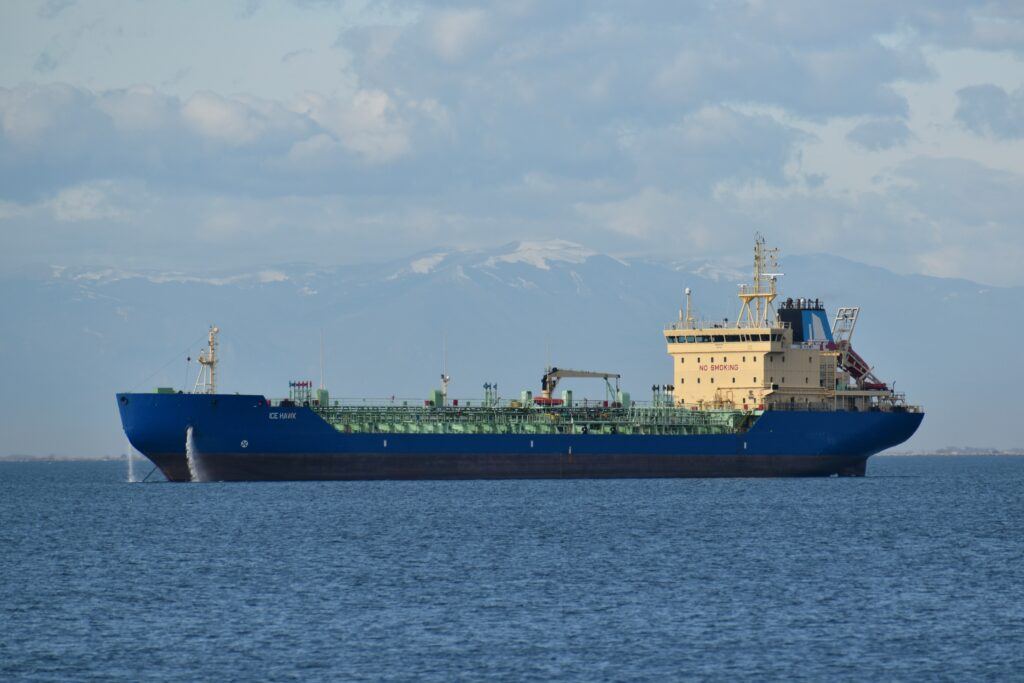
The Beauty is in the Journey
Ship spotting is a fantastic way to connect with the world around you. Embrace the adventure, but remember to be cautious and responsible.
Stay alert, be respectful of your surroundings, and prioritize safety.
Now, with MarineTraffic as your virtual guide and a healthy dose of curiosity, you’re ready to embark on your own ship spotting expedition!
4. Your Outdoor Ship Spotting Toolkit
While you don’t need much to enjoy outdoor ship spotting, a few key items will make your experience even better:
- Binoculars: Your Best Friend
- They’ll let you see ship details and read names from a distance.
- Magnification: 7x to 10x is a good starting point for ship spotting.
- Don’t overspend: You don’t need fancy binoculars to have fun! A basic, affordable pair will be perfect at first.
- Field Guides & Identification Resources
- Books: Look for ship spotting guides with lots of photos and descriptions of common ship types.
- Websites: MarineTraffic (https://www.marinetraffic.com) is a fantastic resource. It lets you find ships in real-time, see photos, and learn their details.
- Notebook: Log Your Adventures
- This is optional but lots of fun! You can jot down the date, the name of the ship, where you saw it, and any interesting observations
- Over time, your notebook becomes a cool record of your ship spotting journey.
- Extras
- Camera: Capture those perfect ship moments, whether it’s with a fancy camera or your phone!
- Comfortable Clothing: Dress for the weather and where you’re spotting.
- Tide Charts: Useful if you’ll be spotting in an area with strong tides, as they affect ship traffic.
Remember: Start simple! You can always add to your toolkit as your love for ship spotting grows.
5. Identifying Major Ship Types
One of the most exciting parts of ship spotting is figuring out what kind of ship you’re seeing. Here’s a quick course to get you started:
Container Ships:

- Massive Size: The defining feature is their size. Modern container ships are truly behemoths, with the largest exceeding the length of multiple football fields. They are some of the biggest moving structures on the planet.
- Towering Stack of Containers: The most visually striking element is the huge stack of colourful shipping containers filling the deck. These containers are neatly arranged in rows and tiers, creating a massive, multi-coloured “wall” along the ship’s length.
- Bridge and Superstructure: Unlike most ships, a container ship’s navigation bridge and the housing for the crew are located far aft (towards the back) of the ship. This maximizes deck space for those containers.
- Boxy Design: Container ships have a less streamlined shape than tankers or general cargo ships. Their wide beam (width) and blunt hull shape are designed to carry maximum cargo rather than for speed through the water.
- Gantry Cranes: While not part of the ship itself, large specialized gantry cranes looming over container ports are a distinctive visual hallmark associated with container ships. These giant structures are designed to efficiently load and unload thousands of containers quickly.
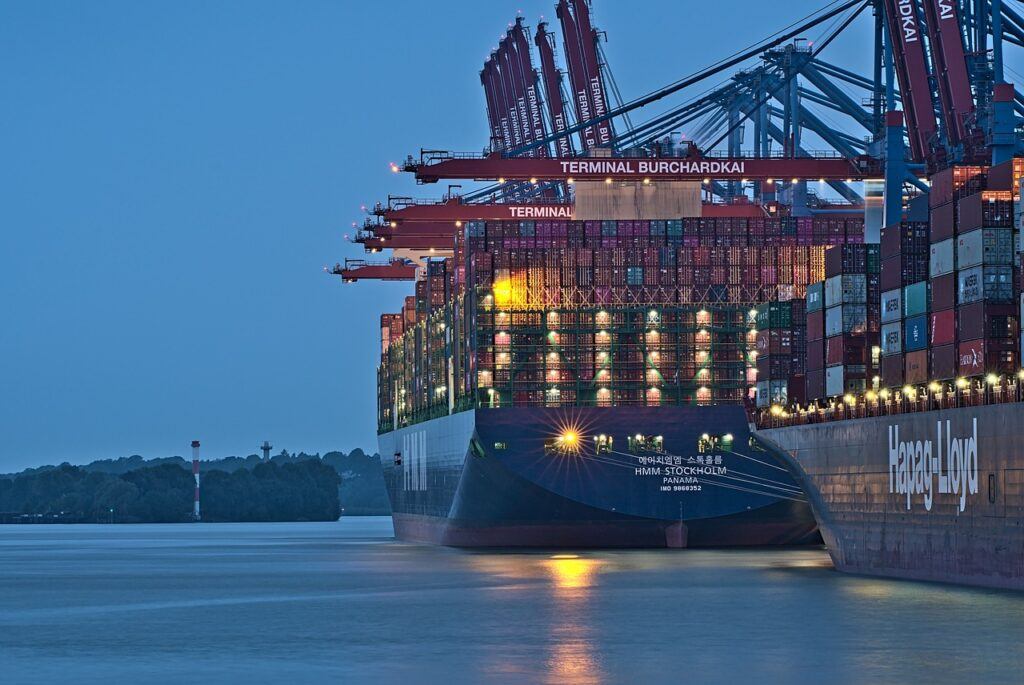
Putting it Together: If you see a massive ship with a wall of brightly coloured boxes dominating its deck, and its bridge located far towards the back, you’re almost certainly looking at a container ship!
🎥🎥🎥Video Time!🎥🎥🎥
Get ready to have your mind blown! We’re about to meet the MSC Irena, the absolute BEAST of cargo ships. This floating city can carry a quarter-million tons and stacks containers 25 STORIES high. But how does this monster even move? And could it survive turbulent seas? Let’s find out!
Bulk Carriers:
Bulk carriers are designed to transport large quantities of unpackaged, loose cargo such as coal, grain, iron ore, or other raw materials.

- Size and Shape: While often smaller than container ships, bulk carriers are still imposing vessels. They have a boxy, utilitarian design with a flat, wide deck to maximize cargo space.
- Large Hatches: The most prominent feature on a bulk carrier is the series of large hatches covering the cargo holds. These hatches have opening and closing roof-like structures to allow loading and unloading of cargo from above.
- Specialised Cranes: While some bulk carriers rely on shore-based cranes, many have their own built-in cranes or conveyor belts to assist in loading and unloading, especially for self-discharging operations.
- Single Bridge: Like most cargo ships, bulk carriers have a single bridge structure containing the navigation and crew quarters. This is usually located towards the aft (rear) of the ship.
Overall Impression: Bulk carriers lack the colourful containers or the sleek lines of other ship types. Their primary visual features are their boxy shape, visible hatches with roof-like covers, and sometimes onboard loading/unloading equipment.
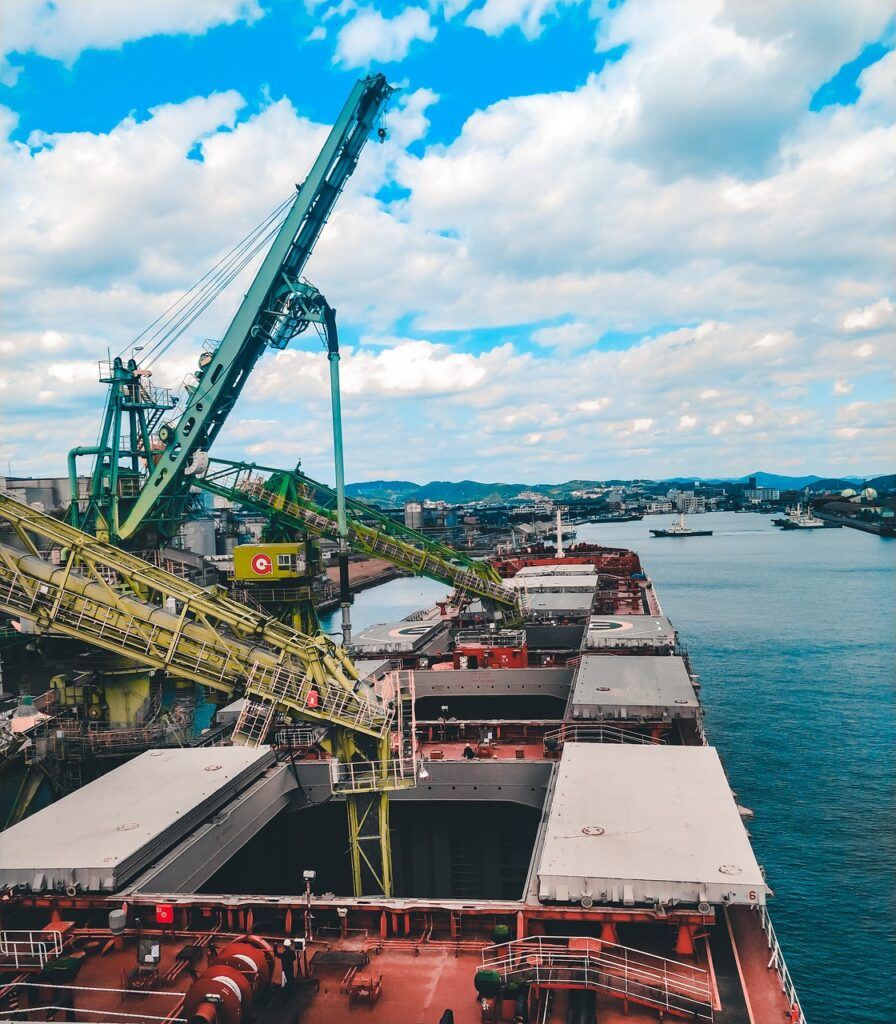
🎥🎥🎥It’s Video Time!🎥🎥🎥
Hold on tight! Today is cleaning day onboard this giant bulk carrier. Watch our crew gear up and get to work in a space bigger than you probably imagine it to be! From power washing to sweeping, we’ll show you how it’s done deep inside a ship designed to carry mountains of cargo.
And…
Watch out for the snazzy dancing!!
Tankers:
Tankers are designed specifically for transporting large quantities of liquids, most commonly crude oil, refined petroleum products (like gasoline), or chemicals.
- Distinctive Shape: Tankers have a long, streamlined hull designed for efficient movement through water. They lack the boxy shape of container ships or the open hatches of bulk carriers.
- Smooth Deck: The deck of a tanker is mostly smooth and flat. Instead of stacked containers or visible hatches, the main structures are the pump rooms and piping systems on the deck.
- Piping Systems: A complex network of pipes and valves runs along the deck and sometimes along the sides of tankers. These are used for loading, unloading, and transferring cargo between tanks within the ship.
- Rear Bridge: Similar to other large cargo ships, tankers usually have their navigation bridge and crew quarters located towards the rear (aft) of the ship. This maximizes the forward space for cargo tanks.
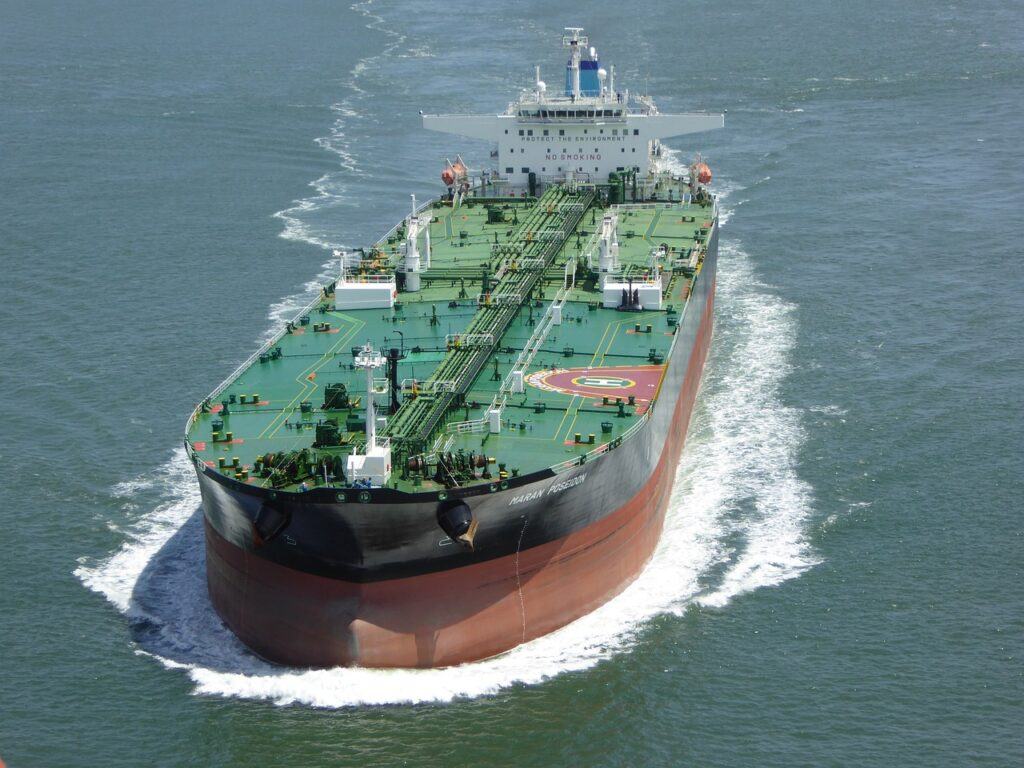
Tankers come in various sizes and specializations:
- Oil Tankers: The most common type, designed for crude oil or refined fuels.
- Chemical Tankers: Equipped to carry various chemicals, often with specialized tanks.
- LNG Tankers: Built to carry liquefied natural gas, they often have distinctive spherical or cylindrical tanks visible above the deck.
Visual Identification: Look for the combination of a long, sleek shape, a smooth deck with piping systems, and a rear-located bridge to easily identify a tanker ship.
🎥🎥🎥Video Time!🎥🎥🎥
It takes more than steel and pipes to move oil. Tanker crews are some of the most skilled seafarers out there. In this video, we’ll look at the technology of tankers, but also the bravery and expertise of the people who work on them
Cruise Ships:
Cruise ships are designed for leisure and travel, focused on passenger comfort and amenities rather than just cargo transport.
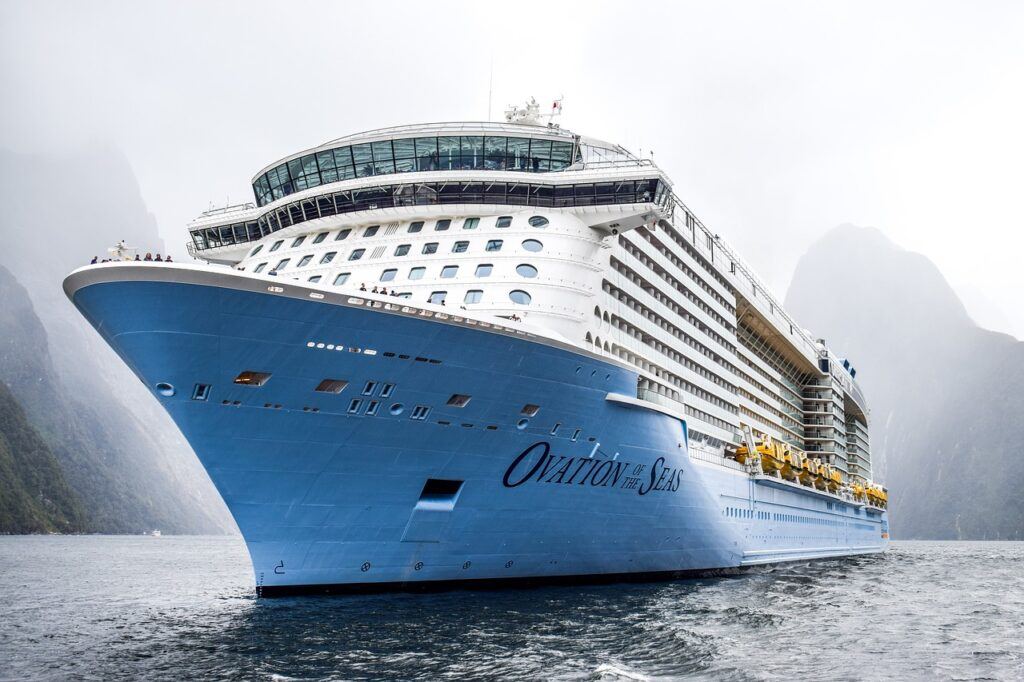
Distinctive Features:
- Multi-Level Superstructure: Cruise ships have a towering superstructure that rises multiple decks above the hull. This space houses cabins, restaurants, pools, entertainment areas, and more – think of it like a multi-story resort on the water.
- Protruding Lifeboats: Safety regulations dictate that cruise ships have numerous, highly visible lifeboats along the sides of the ship. These are usually painted orange and stand out against the ship’s hull.
- Balconies: Many cruise ship cabins feature private balconies, creating a distinctive visual pattern along the exterior of the ship.
- Pools and Sun Decks: Look for open decks near the top of the ship that are designed for sunbathing, pools, hot tubs, waterslides, and outdoor activities.
- Sleek Bow: While not as streamlined as tankers, cruise ships still have a reasonably sleek bow design compared to boxy cargo ships. This helps them cut through the water for smoother sailing.
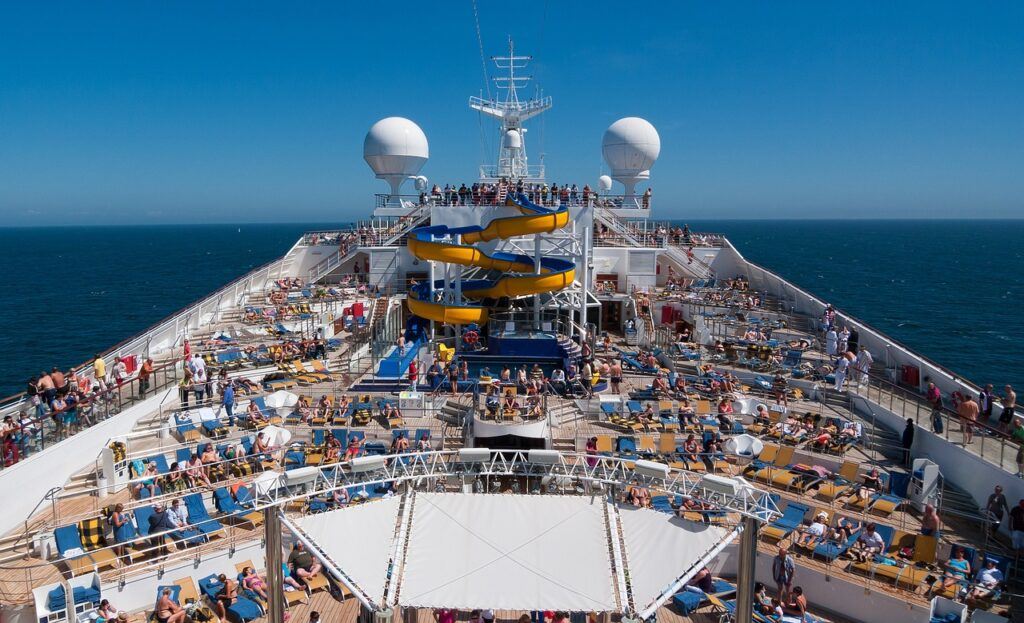
Additional Clues:
- Size: Cruise ships can be absolutely massive, often dwarfing cargo ships in port.
- Livery: Cruise lines often use bright colours and distinctive logos on their ships’ hulls.
Overall Impression: When you look at a cruise ship, think of a floating resort packed with amenities. Their multi-level design, numerous balconies, and focus on leisure facilities make them stand out from other ship types.
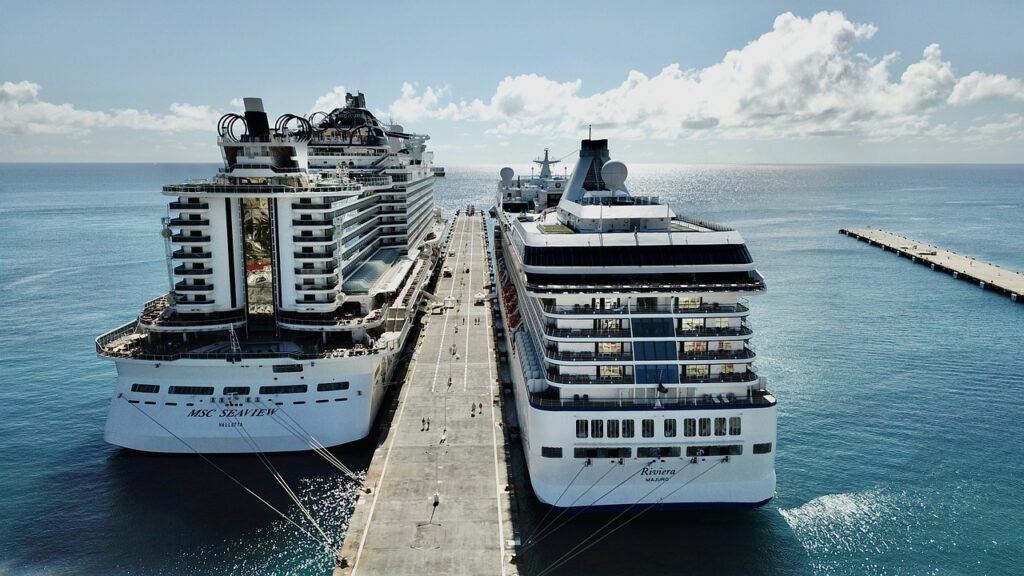
Ferries:
Ferries are designed to transport passengers, vehicles, and sometimes cargo over short to medium-distance routes across bodies of water.
Key Characteristics:
- Wide, Flat Hull: Ferries have wide, relatively flat-bottom hulls for stability and maximizing space for cars, trucks, and passengers.
- Loading Ramps: The most distinctive ferry feature is the presence of large ramps on the bow (front) and/or stern (back) for roll-on/roll-off loading of vehicles. These ramps are often hinged and create a visible opening into the ship’s vehicle deck.
- Open-Air Vehicle Decks: Many ferries have dedicated open-air decks for storing vehicles. These decks are often visible from the side, sometimes with multiple levels.
- Passenger Areas: Ferries also have passenger areas, which can range from basic enclosed seating to more elaborate amenities like cabins, shops, or restaurants depending on the route length.
- Double-Ended Design: Some ferries are double-ended, meaning they have a ramp and bridge at both ends to avoid needing to turn around, enhancing efficiency.

Overall Impression: Ferries have a utilitarian, boxy shape compared to the sleek lines of cruise ships. The defining characteristic is the presence of those loading ramps, making their purpose immediately apparent.
Additional Notes:
- Ferries come in a huge variety of sizes, from small passenger ferries on rivers to massive car ferries crossing seas.
- Ferry design is often route-specific. A ferry operating in narrow waters will look different from one on open sea routes.
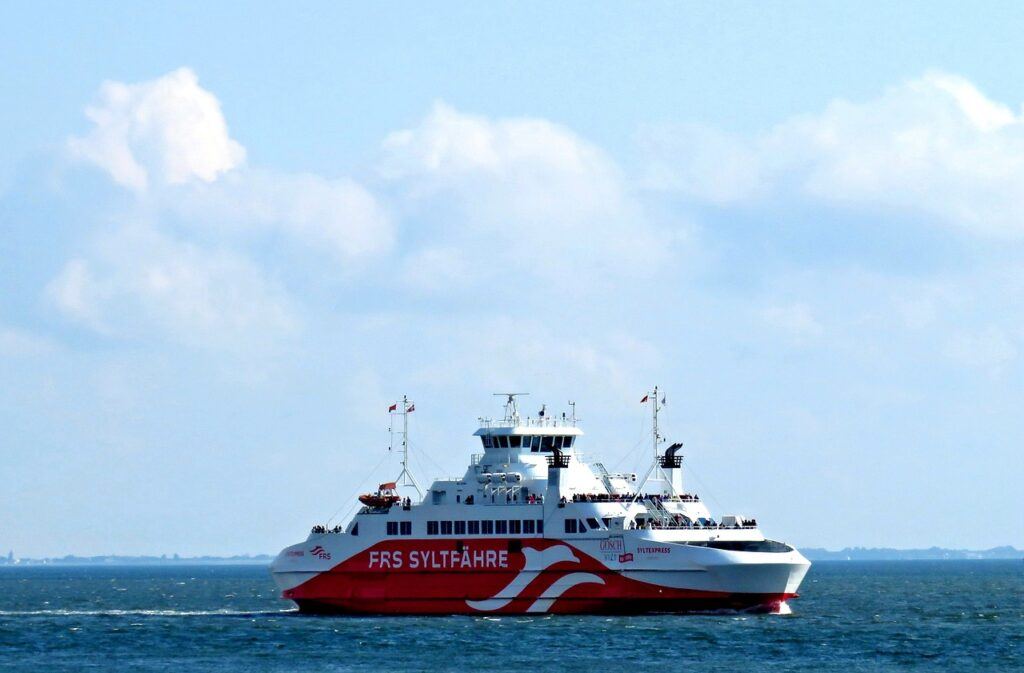
6. Ship Anatomy and Identification
Now, let’s embark on a linguistic voyage as we explore the fascinating names of a ship’s parts! From bow to stern, these terms tell a rich maritime story, whispering tales of nautical tradition and the evolution of the seas.
The Front Lines
- Bow: The sharp, forward part of the ship slicing through the waves. This word stems from the Old Norse “bogr” meaning shoulder – think of the bow as the sturdy shoulder of a ship shouldering its way through the water.
- Stem: The most forward timber at the bow, forming the backbone upon which the bow’s structure is built. This likely evolved from the Old Norse “stafn” referencing a supporting beam, showing its critical structural importance.
- Bulbous Bow: That curious rounded bulge below the waterline on modern ships? It might look odd, but it reduces drag, saving fuel. Intriguingly, this technology was inspired by warships of the early 1900s!
The Rear Guard
- Stern: The back end of a ship. This is where you’d find the rudder and the ship’s name proudly displayed. Its origins lie in Old Norse “stjórn” meaning steering, emphasizing its role in controlling the ship’s course.
- Poop Deck: The highest deck at the stern – a rather comical name indeed! Historically, on tall ships, it resembled a castle-like structure rising above the main deck. This comes from the Latin “puppis” meaning stern, perhaps due to its imposing presence.
The Body & Soul
- Hull: The ship’s main body, holding everything together. Its origins lie in the Old English “hulu” meaning a husk or shell – essentially it’s the vessel’s protective outer layer.
- Keel: The mighty ‘spine’ running along the ship’s bottom. This crucial piece keeps it upright, and its name evolved from the Old Norse “kjölr”, signifying the backbone of a vessel.
Words from the Sailing Era
- Mast: The tall, vertical poles supporting sails. “Mast” comes from the Old English “mæst”, originally used for the long pole carrying a ship’s primary sail.
- Deck: The horizontal surfaces or ‘floors’ of a ship. It shares roots with the Dutch “dek” and German “decken”, meaning to cover – these decks form the essential covering of the ship.
This is just a taste of the rich vocabulary of seafaring! From “starboard” (the side where the steering oar was once located) to “galley” (the ship’s kitchen named after the long, narrow style of warship), each nautical term carries a weight of history and seafaring tradition.
Fun Fact: 🚽 🚽 🚽
Did you know there’s a place on a ship called the “head” and it’s not where the captain sits?
The “head” of a ship is actually its toilet! Why? Traditionally, sailors did their business at the very front (the bow) of the ship, hanging over the side. This was the “head” of the vessel where the wind and waves would, well, take care of the rest!
Flags and Markings: Decoding a Ship’s Identity
- Country Flag (Ensign): This large flag, flown proudly at the stern (rear) of a ship, reveals its nationality or country of registration. It’s a vital clue for understanding the regulations the ship follows and its home port.
- Ship Name: A ship’s name is more than just a label; it’s a source of pride and tradition. You’ll usually find it painted in large, bold letters along the sides (port and starboard) and across the stern.
- Funnel Markings: While practical for venting smoke, a ship’s funnel (or smokestack) is also a canvas for company branding. Many shipping lines have distinctive logos, patterns, or colour schemes on their funnels, aiding identification even from a distance. Think of it like the jersey of a sports team, but for ships!
- Beyond the Basics
- IMO Number: This unique 7-digit International Maritime Organization number is like the ship’s permanent ID. It’s often found on the ship’s side or superstructure, helping track individual vessels even if they change names or owners.
- Call Sign: Each ship has a unique call sign, a series of letters and numbers, used for radio communication. It’s like the ship’s nickname on the airwaves.
- Signal Flags: Ships use a colorful array of International Maritime Signal Flags to communicate messages like “diver down” or “vessel not under command.” It’s an age-old language of the sea!
Tip: With resources like MarineTraffic, you can often look up a ship by its name or IMO number. These websites then provide a world of information, including photos, destination, and technical details – unlocking even more secrets behind its markings!
Want to Learn More?
Check out these short and informative YouTube videos for a deeper dive into ship anatomy:
7. Taking Your Ship Spotting Further
Ready to dive deeper into the world of ships? Here are a few ways to expand your ship spotting adventures:
Connect with the Community
- Local Clubs: Search online or ask at libraries or maritime museums to see if there’s a ship spotting club near you. A great way to learn from experienced enthusiasts!
- Online Forums: These are treasure troves of information, photos, and discussions. A few popular ones include ShipSpotting.com and forums dedicated to specific ports.
Advanced Tools
- Ship Tracking Apps: Go beyond MarineTraffic and explore apps that offer even more detailed ship information and tracking features.
- In-depth Reference Books: As your interest grows, specialized guidebooks provide detailed information on ship histories, shipping companies, and much more.
Photography Tips
- Lighting is Key: Early morning and late afternoon light can be beautiful for ship photos.
- Interesting Angles: Don’t just take side views! Try getting low to show the ship’s scale or experiment with unique compositions.
- Patience Pays Off: Wait for that perfect moment when a ship aligns with a landmark or another interesting object in the frame.
Most Importantly: Keep having fun and exploring! The world of ship spotting is vast, and there’s always something new to discover.
